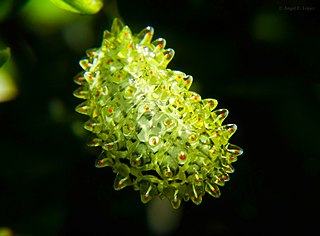
Mimallonidae (mimallonids), sometimes known as "sack-bearer" moths for the larval case-building behavior, are a family of Lepidoptera containing over 300 named species in 43 genera. These moths are found only in the New World, with most taxa occurring in the Neotropics. Adult moths are externally similar to those belonging to some of the other Macroheterocera families Bombycoidea and Drepanoidea, and thus have been variously treated as belonging to either one of these or other superfamilies.

The Dalceridae are a small family of zygaenoid moths with some 80 known species encompassing about one dozen genera mostly found in the Neotropical region with a few reaching the far south of the Nearctic region.

Disphragis is a genus of moths of the family Notodontidae erected by Jacob Hübner in 1820. The genus is confined to the New World and it contains about 137 species.

Acraga is a genus of moths of the family Dalceridae. The genus has neotropical distribution.
Acraga goes is a moth of the family Dalceridae. It is found in Costa Rica, Ecuador, Venezuela, Trinidad, Guyana, Suriname, French Guiana, Colombia, Peru and Brazil. The habitat consists of tropical wet, tropical moist, tropical dry, tropical premontane wet, tropical premontane moist and subtropical dry forests.
Acraga hamata is a moth of the family Dalceridae. It is found in Costa Rica, Panama and possibly Colombia. The habitat consists of tropical premontane wet and rain forests at altitudes above 800 meters.
Acraga infusa, the yellow furry-legs, is a moth of the family Dalceridae. It is found in Guatemala, Belize, Costa Rica, Panama, Colombia, Venezuela, Trinidad, Guyana, Suriname, French Guiana, Ecuador, Brazil, Peru, Bolivia and Paraguay.

Acraga coa is a moth of the family Dalceridae. It is found in southern Mexico, Belize, Honduras, Guatemala, El Salvador, Costa Rica and Panama. The habitat consists of tropical wet, tropical moist, tropical premontane wet, tropical premontane rain, tropical lower montane moist, subtropical wet, subtropical moist, subtropical dry and warm temperate wet forests.
Acraga melinda is a moth of the family Dalceridae first described by Herbert Druce in 1898. It is found in Costa Rica and Panama. The habitat consists of tropical premontane wet and rain forests where it is found at altitudes above 600 meters.
Acraga angulifera is a moth in the family Dalceridae. It was described by William Schaus in 1905. It is found in Trinidad, Venezuela, Suriname and French Guiana. The habitat consists of tropical moist forests.
Acraga isothea is a moth in the family Dalceridae. It was described by Paul Dognin in 1914. It is found in Costa Rica and Panama. The habitat consists of tropical premontane wet and rain forests.
Acraga leberna is a moth in the family Dalceridae. It was described by Herbert Druce in 1890. It is found in Panama and in northern half of South America.
Acraga umbrifera is a moth in the family Dalceridae. It was described by William Schaus in 1905. It is found in French Guiana. The habitat consists of tropical moist forests.
Acraga parana is a moth in the family Dalceridae. It was described by S.E. Miller in 1994. It is found in southern Brazil and Paraguay. The habitat consists of subtropical wet, subtropical moist and warm temperate moist forests.
Dalcerides alba is a moth in the family Dalceridae. It was described by Herbert Druce in 1887. It is found in southern Mexico, Guatemala, Honduras, Belize, Costa Rica, Panama, Colombia and Ecuador.
Dalcerides sofia is a moth in the family Dalceridae. It was described by Harrison Gray Dyar Jr. in 1910. It is found in southern Mexico, Guatemala, El Salvador, Nicaragua and Costa Rica. The habitat consists of tropical moist, tropical dry, tropical premontane wet, subtropical moist, subtropical dry and warm temperate wet forests.
Acraga conda is a moth in the family Dalceridae. It was described by Harrison Gray Dyar Jr. in 1911. It is found in the Guianas.
Dalcerides rebella is a moth in the family Dalceridae. It was described by Schaus in 1911. It is found in Costa Rica and Ecuador. The habitat consists of tropical wet and premontane wet forests.
Dalcerides bicolor is a moth in the family Dalceridae. It was described by William Schaus in 1910. It is found in Costa Rica.
Paracraga argentea is a moth in the family Dalceridae. It was described by Schaus in 1910. It is found in Mexico, Honduras, Belize, Guatemala, El Salvador, Costa Rica and Panama. The habitat consists of tropical wet, tropical moist, tropical premontane wet, tropical premontane moist, subtropical wet subtropical moist forests.



